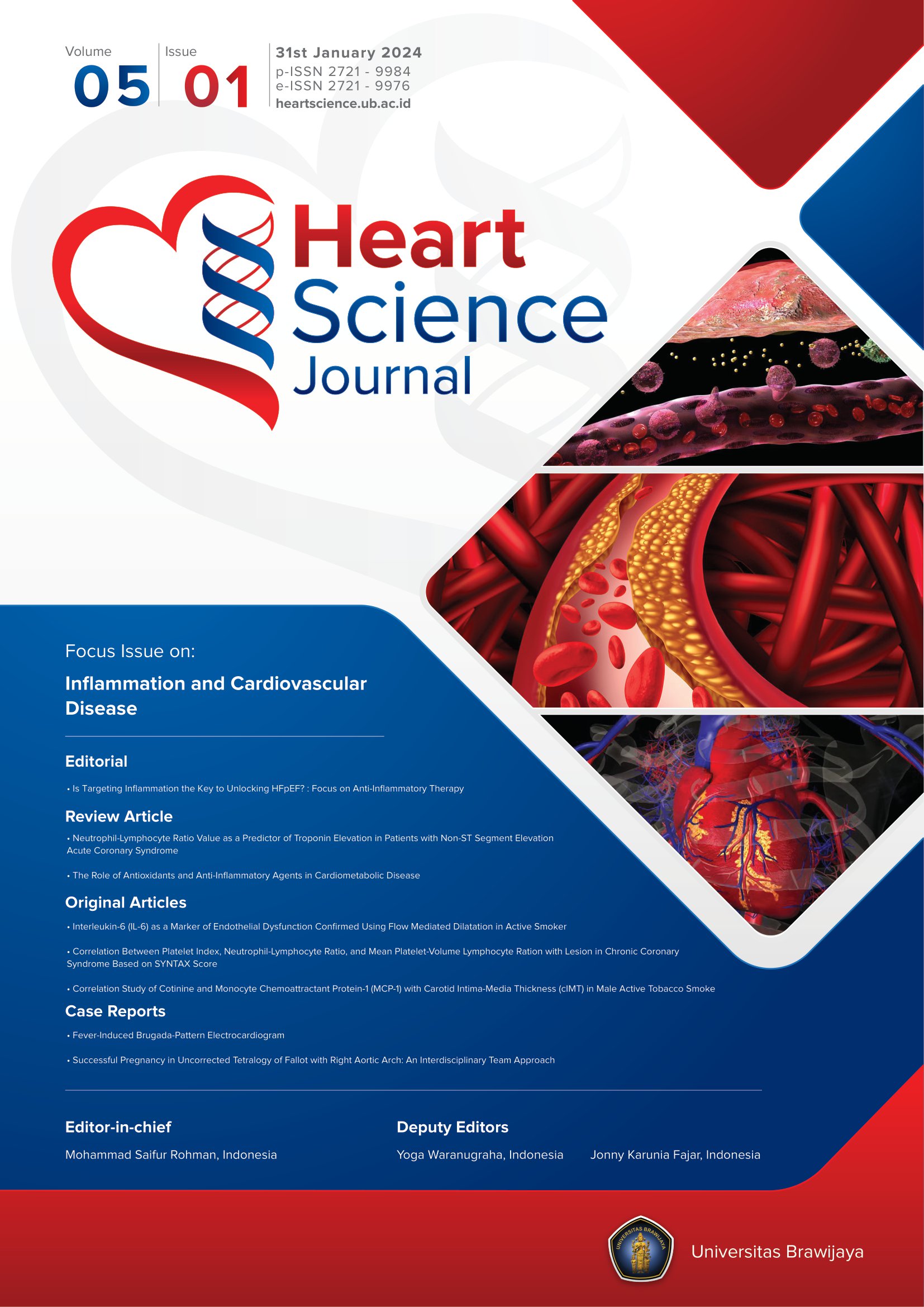Risk Factors for Acute Kidney Injury in ST-Elevation Myocardial Infarction Patients Undergoing Primary Percutaneous Coronary Intervention
Abstract
Background
Acute kidney injury (AKI) is a frequent complication of ST-Elevation Myocardial Infarction (STEMI). AKI occurs in about 10% to 20% of patients with STEMI, which significantly impacts both short-term and long-term clinical outcomes.
Objectives
We purposed to identify the risk factors for AKI among STEMI patients undergoing Primary PCI.
Methods
This retrospective cohort study analyzed 568 STEMI patients who underwent Primary PCI from 2017 to July 2022 at Saiful Anwar General Hospital Malang. We conducted both univariate and multivariate studies to determine AKI risk factors.
Results
The risk factors for AKI among STEMI patients undergoing primary PCI were identified. The OR values for each were as follows: Shock condition (OR = 1.41; 95% CI = 1.18 – 1.92); Killip ≥3 (OR = 3.54; 95% CI = 2.14 – 4.26); and total contrast volume> 145 ml (OR = 1.61; 95% CI = 1.13 – 1.92). Based on the ROC curve analysis, total contrast volume >145 ml with an area under the curve (AUC) of 0.75 (95% CI = 0.65-0.85) with a specificity of 0.66 (95% CI = 0.61 – 0.71) and a sensitivity of 0.71 (95% CI = 0.65-0.76).
Conclusion
Our study revealed that the risk factors for AKI among STEMI patients undergoing primary PCI were shock condition, Killip class ≥3, and total contrast volume >145 ml.
Keywords
Full Text:
PDFReferences
Goriki Y, Tanaka A, Nishihira K, Kuriyama N, Shibata Y, Node K. A Novel Prediction Model of Acute Kidney Injury Based on Combined Blood Variables in STEMI. JACC: Asia [Internet]. 2021 Dec [cited 2022 May 28];1(3):372–81.
Shacham Y, Leshem-Rubinow E, Gal-Oz A, Topilsky Y, Steinvil A, Keren G, et al. Association of Left Ventricular Function and Acute Kidney Injury Among ST-Elevation Myocardial Infarction Patients Treated by Primary Percutaneous Intervention. American Journal of Cardiology [Internet]. 2015 Feb 1 [cited 2022 May 28];115(3):293–7.
Tsai TT, Patel UD, Chang TI, Kennedy KF, Masoudi FA, Matheny ME, et al. Contemporary Incidence, Predictors, and Outcomes of Acute Kidney Injury in Patients Undergoing Percutaneous Coronary Interventions. JACC: Cardiovascular Interventions [Internet]. 2014 Jan [cited 2022 May 28];7(1):1–9.
Schmucker J, Fach A, Becker M, Seide S, Bünger S, Zabrocki R, et al. Predictors of acute kidney injury in patients admitted with ST-eleva- tion myocardial infarction – results from the Bremen STEMI-Regis- try. European Heart Journal: Acute Cardiovascular Care [Internet]. 2018 Dec [cited 2022 May 28];7(8):710–22.
Narula A, Mehran R, Weisz G, Dangas GD, Yu J, Généreux P, et al. Contrast-induced acute kidney injury after primary percutaneous coronary intervention: results from the HORIZONS-AMI substudy. Eur Heart J. 2014 Jun 14;35(23):1533–40.
El-Ahmadi A, Abassi MS, Andersson HB, Engstrøm T, Clemmensen P, Helqvist S, et al. Acute kidney injury – A frequent and serious complication after primary percutaneous coronary intervention in patients with ST-segment elevation myocardial infarction. den Uil C, editor. PLoS ONE [Internet]. 2019 Dec 20 [cited 2022 May 28];14(12):e0226625.
Matějka J, Varvařovský I, Rozsíval V, Herman A, Bláha K, Večeřa J, Lazarák T, Novotný V, Mužáková V, Vojtíšek P. Heart failure is the strongest predictor of acute kidney injury in patients undergoing primary percutaneous coronary intervention for ST-elevation myocardial infarction. Kardiol Pol. 2016;74(1):18-24
Sinkovič A, Masnik K, Mihevc M. Predictors of acute kidney injury (AKI) in high-risk ST-elevation myocardial infarction (STEMI) patients: A single-center retrospective observational study. Bosn J of Basic Med Sci [Internet]. 2019 Feb 12 [cited 2022 May 28];19(1):101–8.
Kellum JA, Romagnani P, Ashuntantang G, Ronco C, Zarbock A, Anders HJ. Acute kidney injury. Nat Rev Dis Primers. 2021 Dec;7(1):52.
Di Lullo L, Bellasi A, Barbera V, Russo D, Russo L, Di Iorio B, et al. Pathophysiology of the cardio-renal syndromes types 1–5: An uptodate. Indian Heart Journal [Internet]. 2017 Mar [cited 2022 May 28];69(2):255–65.
Silvain, J., Nguyen, L. S., Spagnoli, V., Kerneis, M., Guedeney, P., Vignolles, N., et al. (2018). Contrast-induced acute kidney injury and mortality in st elevation myocardial infraction trated with primary percutaneus coronary Intervention. Journal British Medical, 104(9), 1–12.
Hayıroğlu Mİ, Bozbeyoglu E, Yıldırımtürk Ö, Tekkeşin Aİ, Pehliva- noğlu S. Effect of acute kidney injury on long-term mortality in patients with ST-segment elevation myocardial infarction compli- cated by cardiogenic shock who underwent primary percutaneous coronary intervention in a high-volume tertiary center. Turk Kardiy- oloji Dernegi Arsivi. 2020;48(1):1.
Wang C, Pei YY, Ma YH, Ma XL, Liu ZW, Zhu JH, et al. Risk factors for acute kidney injury in patients with acute myocardial infarction. Chinese Medical Journal [Internet]. 2019 Jul 20 [cited 2022 May 28];132(14):1660–5.
Ayu NP. Perubahan Kadar Kreatinin Serum Pasca Paparan Media Kontras Pada Tindakan Intervensi Kardiologi. Denpasar: Universitas Udayana; 2018
Wacker-Gußmann A, Bühren K, Schultheiss C, dkk. Prediction of contrast-induced nephropathy in patients with serum creatinine levels in the upper normal range by cystatin C: a prospective study in 374 patients. American Journal of Roentgenology. 2014;202(2):452-458.
DOI: https://doi.org/10.21776/ub.hsj.2023.004.01.5
Refbacks
- There are currently no refbacks.
Copyright (c) 2023 Yudi Putra

This work is licensed under a Creative Commons Attribution 4.0 International License.









